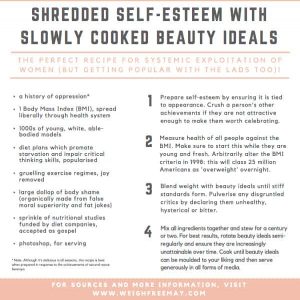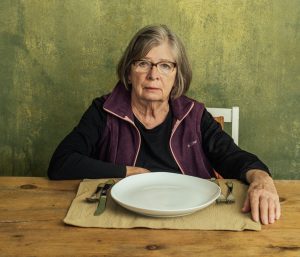I am not reducing my weight so I can put more attractive selfies on Instagram. This should be of no surprise. My motivation is a lot simpler. It is to live actively in my later years, with few(er) medications and other support mechanisms.
My goal for 2017 was a weight reduction from about 110 kg, to 85 kg. I did not succeed. On 2018-01-01 I weighed 87.2 kg after a couple of weeks of excessive feasting associated with Yule. Undeterred, my goal for 2018 is 80 kg. If I end up at 82 kg, only my pride will be hurt.
24 year old Perth, Australia, student Grace Ritter is in a different life situation, recovering from an eating disorder that dominated her life for 10 years. She has started a campaign “Weigh Free May”. As can be seen from a poster from her website, she is targeting other issues. While it may be (politically and otherwise) correct for her to avoid weighing herself in May, I know that would not work for me.

While it may appear that I am simply targeting weight, my goal is actually to foster activity: physical and mental. Yes, I am eating smaller portions of desert and meat, and larger portions of fruit and vegetables. Eating is only part of the formula. Exercise is equally important. While I may not be Norway’s most enthusiastic skier, snow does provide an opportunity for me to exercise in the form of shovelling. At other times of the year there are opportunities for walking and hiking. Working in the shop, provides an opportunity to exercise other muscle groups, particularly the arms.
A note about BMI
Note: BMI, Body Mass Index aka Quetelet Index, was devised by Adolphe Quetelet (1796-1874), in the period 1830 to 1850. It is useful for comparing sedentary populations, but is not designed for saying anything about individuals. Weightlifters, and others with a large muscle mass, will have a high BMI, despite being fit. At best BMI is a guideline
At yesterday’s weigh in, my BMI = 24.4 This is an acceptable level, but I cannot afford to put on much weight, if I am to stay under the magical 25 boundary that distinguishes normal from overweight.
I note that the restaurant industry association, Center for Consumer Freedom, are critical to the use of BMI. The index is calculated using weight and the square of height. Since mass increases to the 3rd power of linear dimensions, taller individuals with exactly the same body shape and relative composition have a larger BMI. Short people are misled into believing they are thinner than they are, while tall people are misled into thinking they are fatter.
Since, ethnicity and gender factors, such as height, influence how BMI results should be interpreted, I have used my participation in the North-Trøndelag Health Study, and medical check-ups, to see where I stand.
There are people who are skinny, but have high levels of body fat. I do not seem to be one of those. I am less worried about being underweight than overweight. Even if I reduced my weight to 70 kg, I would still have an acceptable BMI = 20.0



